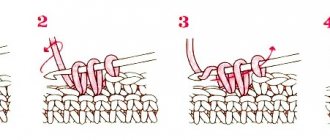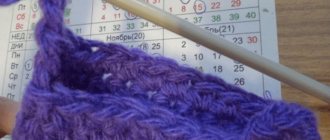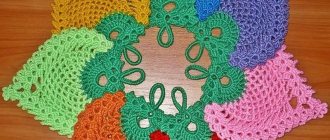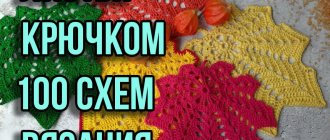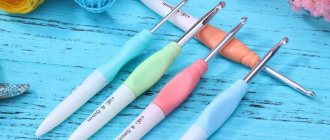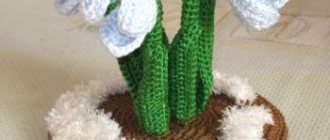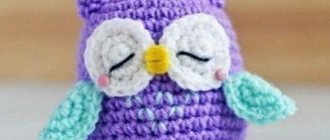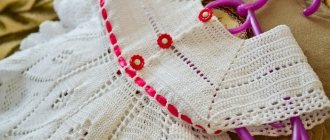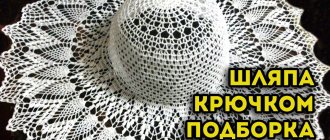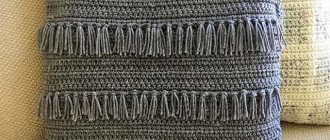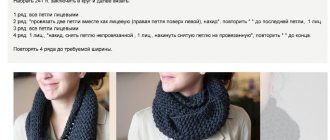Drinking tea for pleasure is not about rushing. It's about leisurely movements, beautiful napkins on the table, homemade shortbread cookies, “delicious” conversations with loved ones and cute, charming accessories that bring their own notes of magic and atmosphere to the action. A hot water bottle for a kettle is not about necessity. Today, few people brew tea according to all the rules, and those who do may well use a couple of towels to wrap the teapot to better maintain the temperature of the water. A heating pad for a teapot in general, and even a heating pad for a teapot with your own hands , is about love for details, the desire to decorate your personal world in the colors of joy and smiles, about drinking tea as a pleasure. To turn every day of your life into a holiday, it is not at all necessary to make plans and think through something grandiose. It is enough to be able to notice the beautiful and pleasant in trifles and sometimes be able to give them to yourself. Figure out how to crochet a heating pad for a teapot - this is a very good gift for yourself.
How to knit a heating pad for a teapot - 5 patterns:
Hot water bottle "Rose"
A heating pad according to this description can be knitted in two sizes: for a teapot for 4 or 6 mugs.
We will need:
- yarn, 100% cotton, 71g per 109m – a skein of raspberry (No1), plum (No2), blue (No3), light green (No4), white (No5), carrot (No6), red (No7);
- hook No.5.
Density: 13 StBN for 14 rubles. equal to 10 cm by 10 cm.
Description
For the heating pad we knit two identical parts. We alternate color stripes every 2 p. in sequence: No1, No2, No3, No4, No5, No6, No7, No6, No5, No4, No3, No2, No1 (see photo).
We cast on with yarn No. 29; 36 VP and knit according to diagram 1, performing repetitions of the last one. row up to level 10; 13cm. We complete the pattern purlwise. R.
We perform the top of the part according to diagram 2, knitting 6p. Then we move on to diagram 3: raise it by 3p. and at 4 p.m. 10 VP and knit them together with the loops raised from 1p. and 2p.
Next row: 1 VP, 1 single stitch in the 1st stitch, [2 SC in two chains of 10 VP, 1 SC in the next row. p.]x3; 4 times, 1 sc in last. StBN. In total we have 11;14st. Let's turn the work around.
Next r.: 1 VP, 1 sc in the 1st sc, 2 sc with a common top x 5; 7 times, 1 sc in the next. 0; 1 StBN. Cut the thread and fasten it.
We knit the second half of the heating pad. We sew the parts together, leaving 6 gaps for the handle and spout of the teapot; 8.5 cm. According to diagram 4, we knit a flower and sew it to the heating pad.
Pestle for teapot
Sewing a heating pad for a chicken-shaped teapot is not as difficult as it might seem. Having prepared the fabric for the inner and outer layers, insulation (batting, padding polyester), threads, scissors, sewing machine and needle, you can start working:
- To make the body, you need to determine the dimensions according to the same scheme as in the case of a heating pad in the shape of a cap. To avoid a seam along the top edge of the warmer, fold and cut the paper measure into two equal rectangles, then join them together at the long sides. The result is a rectangle whose height is twice its length. Thus, the seams will be at the front and back, which will add rigidity to the structure. But it’s better to sew it after the wings and tail are sewn on.
- The wing pattern can be made by drawing a right triangle with a height equal to half the back and a base 2/3 of the height. The corners need to be rounded. The combination of white stripes and the fabric from which the upper layer of the body is made looks impressive. Now the wings need to be sewn to the body, adding a little padding polyester for volume.
- The tail is also a triangle, but isosceles. Its base is equal to half the length of the back, the other two sides are 2 cm shorter. You need to cut out two such figures from a canvas stitched from white and stripes of the same color as the body. After this, you need to fold them with the right sides inward and sew along the sides. Turn it inside out, fill it with a small amount of padding polyester, and sew “feathers” along the border of the stripes. Having retreated a fifth from the edge along the line of the back, align the middle of the base of the tail with the resulting point. Now you need to sew it on, first placing the triangle in the opposite direction (towards the head), and then, turning it away, stitch it again. In this case, the tail should protrude beyond the body by a third of its height.
- Now you can sew the main part of the heating pad front and back.
- To make the head, you will need two round pieces of white fabric. The diameter is almost half the length of the back.
- The easiest way to make a comb is from stitched red fabric. By wrapping a 2 cm wide strip at an angle of 45 degrees alternately to the right and left sides, you can form a ridge. Stitch to secure folds.
- The beak is a triangle, folded from a two-centimeter yellow ribbon and stitched together.
- You will get two beards if you sew together two red circles with half the diameter of the white ones. After this, the circle is cut in half, turned inside out, and quite a bit of padding polyester is placed in each half.
- Now you need to place the comb and beak on the round blanks, perhaps even baste them, and then sew the head, stepping back half a centimeter from the edge and first folding it with the front surface inward. Do not sew a third of the circumference - through this hole the head will be filled with padding polyester. The unsewn part should start from the beak.
- For each white blank, it is necessary to baste the beards immediately under the beak, after which the head is “planted” on the corner of the chicken body and swept off by hand.
- All that remains is to make the eyes. You can use black buttons, embroider them with floss threads, or simply draw them.
Hot water bottle with caps
We will need:
- brown yarn for the top of the warmer;
- black yarn for the bottom of the heating pad;
- some yarn of different colors (see photo);
- hook No. 1.75 and No. 5;
- filler.
Description
From black threads we collect 60 air stitches. loops and knit 3p. RLS. Next, we divide the knitting in half (30 stitches each) and then knit each of the parts separately, switching to brown yarn. We fulfill 16 rubles. columns without/n.
We connect the parts and knit a stitch without / n, making decreases in each. R. 6 loops each. When the number of loops is 20, we begin to knit a cone.
Next Decrease 1 stitch on 4 rows. in everyone. We switch to yellow yarn. and knit 7p. RLS. Next 2 rubles decrease by 5p.
Cones
Choose the thread color as desired. For one cone, we collect a chain of 3 VPs and close it into a ring. Further:
- 1st row: 7 sc in the middle of the ring;
- 2nd rub.: +7 increases;
- 3 rubles: +5 increases;
- from 4r. 10 rubles: without additions we knit sc;
- from 11 p.m. 18 rubles: + 2 increases in each rub.
We make three more cones of different colors.
Assembly
We decorate the cones with yarn tassels, fill them with stuffing and sew them to the heating pad.
Delicious tea in a cozy atmosphere
Many people call the teapot warmer by another name - Dunyasha. A doll made with your own hands for a teapot, using patterns that were used back in Tsarist Russia when creating a samovar babka, exudes comfort and warmth. The difference, perhaps, is only in the selection of materials. As for the doll itself, there are many options:
- Russian beauty with a porcelain face;
- funny tilde;
- chubby rag toy.
The top of an old but in good condition plastic doll will also work. The working part of the product is a skirt, which is made according to the principle of a cap. Dimensions for the pattern of a life-size teapot doll are made using paper wrapped around the teapot.
If the top fabric along the bottom edge is not connected to the insulation and the inner layer, you should first make the functional part: spread the insulation between two rectangles of cotton fabric and quilt it. The resulting blank measures 29x74 cm and will become a heat-insulating bell after the side, bottom and top seams are stitched. Using an elastic band in the drawstring, tighten the base.
Second master class
I hope you have heard about the woman on the samovar? Here. Let's make a hot water bottle doll. Believe me, this is also not difficult, since we will use only affordable materials available in every home, which means we won’t have to buy anything special. You are already quite an experienced master.
Baba on a samovar or hot water bottle doll
So. Are we sewing a peasant young lady, a merchant's wife or a society lady? The less we guess, the more interesting the result. In addition to the materials that were used for the base of the previous craft, we are looking in the house for everything that could be useful for an exclusive and truly magnificent work.
We will need:
1. Sew according to the pre-measured dimensions of the base. You already understand how this is done. But I propose to simplify the task even further and, as a pattern, draw a regular rectangle, the length of which is equal to the diameter of the teapot, including the spout and handle. The height is also known. Don't forget to add 2cm for seams. This will be the base, also known as the underskirt.
Popular articles 11 photos of ideas for excellent beaded gifts for the New Year 2022 with your own hands
2. You need to stitch together the folded parts of the base with just one seam.
3. Carefully hem the bottom of the skirt and gather the top into a gather, not forgetting to leave a hole for sewing in the body.
Now the underskirt is ready. You can leave everything in this form, additionally placing a nice apron on top of the finished doll, which can always be removed and washed if necessary. Which, of course, is very convenient.
But, if all this seems not enough for you and your imagination continues to run wild, do not deny yourself the pleasure of amusing your imagination and start sewing a chic overskirt.
4. Overskirt.
If you decide that your product is not a simple woman on a samovar, but an exclusive work of art, then do not limit your possibilities. Use beautiful bright fabrics, lace, ruffles, flounces, artificial flowers and all sorts of fashionable accessories. Anything is good. Sew the finished top skirt along the side seams. Fold the bottom. Once again, evaluate whether all the details are applied and fasten with a cotton base.
That's not all. A little patience.
5. To complete the masterpiece, you will have to find or make very important parts. For them, you can use elements of an old rubber doll. Of particular value is the head, where everything is already there: eyes with eyelashes, lips, rosy cheeks and even hair. If there is no extra doll in the house, then you will have to work a little more and sew the head, torso and arms separately. Or you can link it. Experiment. Old knitwear, socks or tights can also help out here.
6. We sew up the sewn or knitted head, turn it inside out and stuff it with filler. The pattern for the head is simple and depends on the size of the doll. I suggest using the following.
7. To create hair and style your hair, use any yarn, including bright and colored ones. You can use a soft base to embroider a smooth hairstyle with a parting in the middle, and then braid voluminous braids or tie funny ponytails with bows. Or you can immediately create a full head of hair by first loosening an old scarf, which will give volume and a curl effect. If you decide to dress the young lady in a knitted hat, turban or a spectacular deep hat. In this case, you won’t have to bother with making hair.
8. Cut and cut the arms and torso according to a simple pattern that does not require exact dimensions. One condition is that all parts of the body must correspond to each other. Each part requires two pieces. Sew them together with neat seams, turn them inside out and stuff them with filling. It is convenient to use knitted materials.
The patterns are so simple that you don’t have to look for them on the Internet. You can easily draw them yourself:
9. The arms, torso and ready-made head must be connected to each other to form a whole workpiece.
10. Finishing touches. Embroider funny eyes, nose and smile. Dress the doll in a smart blouse. All you have to do is carefully fasten the workpiece to the base (lower and upper skirt). All.
Just great. The result was not a woman at all, but a charming girl. But as soon as you put a crown on her head, she will already be a princess. And with a rose in your black hair you can end up with a beautiful gypsy.
Experiment. Believe me, there will be no limit to the delight of family and friends. Now you know how to sew a heating pad for a teapot with your own hands. Have no doubt, the ability to make such souvenirs will definitely come in handy. You can now give a master class to anyone. Moreover, the issue with gifts has now been resolved once and for all. Moreover, such textile products are now in fashion. This is also a functional gift. After all, it not only decorates the kitchen, but also allows you to retain heat inside the kettle for a long time. That's what we wanted. Enjoy your tea.
Owl
To sew such a heating pad we need:
- coffee-colored fleece;
- felt in white, yellow, black and blue colors;
- felt or fleece of carrot color;
- cotton fabric for the inner cover;
- threads, needles, scissors, sewing machine.
Description
We draw out 1⁄2 of the pattern for half of the main part according to the size of our teapot, and cut it out.
Fold the coffee-colored fleece in half and cut out the main piece with seam allowances. Then we cut out a second similar one.
We straighten out the details.
We cut out the details of the inner cover from cotton fabric.
We cut out decorative details - blue feathers, white eyes, black pupils.
We cut out the wings and beak from carrot-colored material.
We cut out feathers and eyebrows from yellow felt.
On one of the main parts we lay out the elements of the owl's face. We fix them with pins.
Sew on with matching threads by hand or by machine.
We fold the two main parts inside out and sew along the upper contour.
Next, we will sew a cover from cotton fabric.
We put the main cover into a cotton fabric cover with the right sides facing each other.
Sew the bottom seam, leaving a gap for turning.
Turn the toy inside out and straighten it out.
We tuck the inner cover under the outer one. Sew up the gap with hidden stitches.
Set of two potholders and a heating pad in patchwork technique
To make the kit we will need:
- thin fabric for the base;
- shreds of different colors;
- fabric for the bottom lining;
- seal;
- needles, threads, pins, sewing machine.
Description
We cut out the parts of the base on which we will create the patchwork fabric. Determine the shape and size of the parts as you wish. If the heating pad is made for a teapot, you need to measure its largest circumference and height. The width of one base piece should be a couple of cm wider than 1⁄2 its circumference. For the heating pad we cut out two parts of the base, for potholders - one at a time.
In the center of the base we place a small but bright piece of fabric, orienting it with an inclination relative to the sides of the base part. We place the second patch face down on one edge of the central patch and secure it with sewing pins.
We sew at a distance of 0.5 - 0.7 cm from the edge.
Turn the sewn fabric over to the right side and iron it.
Then, moving clockwise, sew on the remaining patches. Each new flap should overlap the previous sections. Pay attention to the color combination of the flaps. Once completed, each seam is ironed along the front side.
In this way, we create a fragment of patchwork fabric on the base.
We cut the workpiece to the size of the base.
Similarly, we create patchwork blanks for the second potholder and heating pad. We cut out the parts of the potholders and heating pads from the insulation. From the lining fabric we cut out the lower parts of the potholders and heating pads.
We chop off a sandwich from the base, insulation and lining with pins and sew a stitch along the edge at a distance of 0.5 - 0.7 cm from the edge. Trim the edge as necessary.
We make bias binding 30 - 40 mm wide for turning potholders.
We make a loop. We attach the facing, folding it with the main part with the right sides. Don't forget to insert a loop into the seam.
We wrap the edge of the part with the facing, bend the cut and stitch it.
We fold the two parts of the base with the stitched patchwork fabric with the right sides facing inward. We insert a loop at the top. Sew along the contour, except for the bottom. Similarly, we grind two parts from the lining.
Turn out the patchwork cap. We insert the cap from the lining into the main part.
Finish the bottom edge with a facing.
Hen
Such a cute hot water bottle chicken can be made using the patterns presented below.
Another version of the chicken warmer can be sewn from felt or any non-flowing material.
The pattern and step-by-step master class are presented in the photo below.
Pink kitty
The pink cat is a modern kitchen accessory that can be made by hand. It is designed in the same way as a regular heating pad. For this you can use two types of materials. Then the animal's muzzle and the corresponding darts on it, a curved tail, paws and back are created. The muzzle is created in two layers: the first is a lining made of calico, and the second is made of knitwear or other fabric.
You might be interested in this All about patterning and sewing a sundress with buttons on the front
Pink kitty pattern
German and Korean cotton, Russian flax and Belarusian calico are excellent for this. The ears are complemented by an openwork braid. After attaching the muzzle to the created warmer with lining, the paws are sewn on. Then the back part of the cat's body is made and at the end the tail is sewn on. At the very end, the decor is created: eyes, nose, mouth and mustache are sewn on.
Finished model of a pink cat
Tabby cat
To make a cat, you need to take the main part of the heating pad, the lining, the insulation, the tail, the muzzle in the amount of two pieces, and then the fabric for the paws in the amount of four pieces. Then you should take the details of the heart, nose and cheeks.
Tabby cat pattern
First you need to sew the main parts of the heating pad to each other and make the edging. Next, sew a lining to the product and begin constructing the cat. To make a voluminous cat, you first need to sew the tail parts together and iron them using an iron. Then stuff the tail with padding polyester.
The next step is to sew the parts of the muzzle and stuff them with padding poly, just like the nose. Then you should make the paws and sew the tail to the edge of the heating pad. At the end, you can make a loop, ears and somehow decorate the product.
Warmer tabby cat
We sew a textile teapot
I somehow wanted to sew a teapot, but I couldn’t find a detailed master class. And I decided to sew it myself and share the process with you. Please don't judge harshly
So, we will need:
— fabric, for external and internal parts;
— padding polyester or holofiber;
- needle, thread, scissors, pencil, glue;
- and the most important thing is a good mood
We prepare the pattern, use a pencil to transfer it to the fabric and cut out the details.
For the outside of the teapot I took calico in two colors, and for the inside - white cotton fabric.
To get the side walls of two colors, the pattern was folded in half and the top part was transferred to one fabric, the bottom to another. I stitched it and got a solid side wall. Here's what I got.
Next, take the outer side wall and apply cotton lace. We measure according to the size of our wall, cut it and sew it on. And we do this with each outer side wall.
We take 2 parts of the outer wall and 2 parts of the inner wall. Place the outer pieces on top of each other with the right sides facing inward. We do the same with the inner walls. This makes 2 stacks of parts. See the photo below.
Next, we place one stack on top of another. We should get a kind of “little book”. We sweep one side and sew it on the machine.
When unfolding our “little book,” the seam should be on the inside. Don't forget to trim the side seam slightly with zig-zag scissors. If there are no such scissors, then we simply make cuts. So that when we turn the parts right side out, we get an even seam. We have 2 of the 8 side walls ready (photo below).
We sew the remaining walls according to the same principle as before. We apply 1 outer wall and 1 inner wall to one side, so that we get a “book”. We sweep, stitch, cut with a zig-zag and turn right side out. And so we continue with all the other details of the side walls. We also make sure that the cotton lace of one part matches in height with the lace on the other part.
This is how we should get an eight-blade:
To make a round teapot, we connect the side parts of the eight-blade in the same way as before. The outer walls face each other. Internal facing each other. Those. making a “little book”. The result should be a “cocoon” of side walls. Baste and sew.
Carefully turn out our “cocoon” and get the finished side wall of the teapot
Turn it inside out. We take the part of the bottom of the teapot from the inner fabric. We attach it to the teapot. We stitch on a machine.
We prepare the outer part of the bottom. Cut out the bottom piece from cardboard. Glue the fabric part to the cardboard. Next, we apply it to the teapot, secure it with needles and begin manually sewing the bottom to the teapot with a hidden seam.
When 7 of the eight walls have been sewn on, carefully fill the bottom of the teapot with synthetic padding. There should be a convex bottom inside the teapot
Then we sew on wall 8. The bottom is ready
Next, we fill the side walls with padding polyester and form the bulges of the teapot.
Next we need to beautifully decorate the top of the teapot.
Measure the diameter of the top. From the fabric we cut out a strip equal to the length of the measurement and 3.5 cm wide.
We attach it to the teapot as in the photo below. I sewed it by hand, because... The machine did not take the thickness.
We turn the sewn collar inside out, secure it with needles and sew it with a hidden seam. The side can be stuffed with padding polyester for more volume. But in this case, I didn't do that.
The teapot belly is ready!
We make the spout and handle of the teapot. We turn out the parts sewn together and stuff them with padding polyester. We do not completely fill the spout with padding polyester, forming a small recess.
We attach the spout to the belly of the teapot, secure it with needles and sew it with a hidden seam. We do the same with the handle of the teapot.
Next, prepare the lid of the teapot.
The cut cardboard part of the lid turned out to be too big for my teapot, so I had to adjust it to fit.
This is what happens. Glue the cardboard piece to the fabric piece. We go along the edge with a regular seam and quilt the edge. Next we fill it with padding polyester.
Sew on cotton lace.
Next we make a pimple. We take the pimply part, stitch it along the edge and tighten it. We stuff it with padding polyester and sew it to the base of the lid with a hidden seam. We put it on the teapot.
And now our teapot is ready!
Happy creativity! Creating together is great!
I will answer all your questions.
When copying or partially using materials from this master class on other resources, an active link to the source is required.
How to sew an elegant young lady
A charming hot water bottle doll can be made from all kinds of fabric scraps. A textile souvenir made by hand is a fashionable handicraft trend.
The basis of an elegant young lady
A hot water bottle, which is made in the shape of a girl dressed in a fluffy dress, is a traditional kitchen attribute. Previously, it was performed based on the Russian folk peasant and merchant costume. To obtain such a product, you need to make a base and then connect all the patterns together.
Elegant young lady on a samovar
